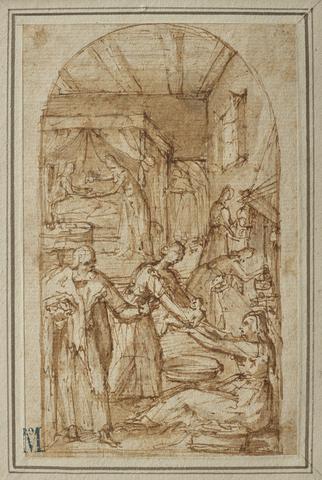
La naissance de Saint Jean-Baptiste
Italie du Nord 16ème siècle
Craie noire, plume, encre brune et lavis brun ; inscription "Sc. ferarese/ No 85" au verso ; 12,7 x 8 cm
Provenance :
Milan et Bergame, Giovanni Morelli ; Milan, Francesco Dubini ; Zurich, Dr Karl Grünwald ; Zurich, Robert Landolt ; Londres, Christie's, 8 décembre 2020 (attribué à Jacopo da Empoli).
Le dessin d’une provenance illustre – Giovanni Morelli, qui fut au 19ème siècle le premier historien d’art à théoriser l’attribution d’une œuvre non signée, non documentée, à un artiste donné – est lui-même, paradoxalement, en recherche d’une attribution.
Resté deux générations, depuis les années cinquante, dans une collection suisse exemplaire, celle du pédiatre Robert Landolt, il n’a jamais été exposé jusqu’à sa vente en 2020 et n’a pas reçu l’attention qu’il mérite.
Il s’agît d’un dessin de composition, une esquisse qui présente comme souvent la double caractéristique d’un petit format, et d’une graphie plus libre que les modèles plus achevés ou les études de détail. Son charme tient à l’intimité, au naturel de la scène, en même temps qu’à sa construction vite et bien pensée. Observons par exemple le rythme des trois figures, de plus en plus penchées vers la droite, qui inscrivent une diagonale en profondeur dans la partie basse de la composition ; ou comment l’accouchée (Sainte Elisabeth), calée dans son lit en haut à gauche, est symétrique, à l’échelle réduite, de la figure (sans doute sa cousine la Vierge) qui accueille, en bas à droite, le nouveau-né.
Cette femme qui tend l'enfant à une autre pourrait être une réminiscence de la fresque de Filippo Lippi la Naissance de Saint Jean-Baptiste (Prato, Duomo) ; et la servante qui écarte un rideau, dans le fond de la pièce, de la Naissance de la Vierge d’Andrea del Sarto (Florence, Santissima Annunziata).
Il s’agit probablement ici d’une naissance de Saint Jean Baptiste. Les deux représentations dans la peinture italienne de la Renaissance sont proches, à la différence près que la naissance de la Vierge est en général une affaire exclusivement féminine ; alors que celle de Saint Jean Baptiste fait intervenir le père, Zacharie, qui « demandant des tablettes, écrivit : Jean est son nom » (Luc 1:63) – même si l’évangile date cet évènement de huit jours après la naissance, à la circoncision.
Ce dessin frappe aussi par la perspective accentuée, en plongée, et le rôle qu’y joue la lumière. Nous proposons, pour ces raisons et d’autres plus « morelliennes » de l’attribuer à Lorenzo Lotto – nonobstant les réminiscences florentines : car il est admis aujourd’hui que Lotto a séjourné à Florence et dans la région, probablement en 1512, et peut-être en d’autres occasions.
Il nous semble très proche, par la graphie nerveuse, l’effet de flash, et jusqu’au trait d’encadrement, d’un autre dessin de composition assez unique parmi la trentaine, à peine, de dessins reconnus du maître, mais dont l’attribution n’a jamais été contestée : le Prélat dans un intérieur (Londres, British Museum).
Par comparaison avec les fresques de la chapelle Suardi, qui présentent la même saveur anecdotique, et la Naissance de la Vierge (Bergame, San Michele al Pozzo Bianco), où l’on retrouve à peu près le même lit, et l’idée de l’enfant ballotté entre deux femmes, nous proposons de le dater autour de 1525, ce qui correspond aussi à la datation du dessin de Londres
Ajoutons que Zacharie, au front dégarni, à la barbe en collerette, nous paraît – notamment de par son geste de la main – d’un type éminemment « lottesque », que l’on retrouve par exemple dans le Saint Pierre de la Transfiguration (Recanati, Museo Civici) … mais aussi le Saint Joseph du Repos pendant la fuite en Egypte, dessin passé de la collection Morelli au Museo del Castello Sforzesco (Milan), toujours anonyme mais dont l’attribution à Lotto nous semble également possible.
